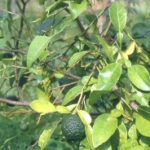| Common Name: |
Lime |
| Botanical Name: |
Citrus aurantiifolia |
| Genus: |
Citrus |
| Family: |
Rutaceae |
| Native Location: |
United States, Italy, tropical Asia, widely cultivated in the West Indies. |
| Cultivation: |
Well-drained, neutral to slightly acid soil in sun, with ample moisture during the growing season. Scale insects, mealybugs, and tortrix moth caterpillars may affect plants under cover. Citruses do not transplant well. |
| Propagation: |
By seed sown when ripe or in spring at 16°C (61°F); by semi-ripe cuttings in summer. Cultivars do not come true from seed. |
| Harvest: |
Flowers (C. aurantium, C. bergamia) are picked when first open and distilled for oil. Leaves (C. aurantiifolia, C. hystrix) are picked as required for flavoring and infusions. Oil is distilled from foliage, unripe fruits (C. aurantium) and ripe fruits (C. bergamia). Fruits are picked when unripe or ripe for culinary use, candying, or oil distillation, and either unripe or ripe (C. aurantium, C. reticulata) for use in Chinese medicine. |
| Variations: |
C. aurantiifolia x Fortunella japonica
(Limequat)
Has fruits similar in appearance to kumquats but yello-green and lime-flavored. Easier to grow in cooler areas than the true lime.
Mexican
(Key lime, bartender's lime, West Indian lime)
Is compact and thorny, with small, round, yellow-green fruits that have very thin skins.
Tahiti syn. 'Bearss'
(Persian lime, Tahitian lime)
Has oval, seedless fruits of excellent flavor. |
| Height: |
3-5m (10-15ft) |
| Width: |
2-3m (6-10ft) |
| Hardiness: |
Min. 13°C (55°F). Sometimes withstand short periods at 0°C (32°F). |
| Extraction: |
Expression |
| Parts Used: |
Leaves, fruits, peel, oil. |
| Color and Odor: |
The essential oil is clear with a hint of yellow. It has a sweet, fresh, zesty aroma. |
| Background: |
The lime tree originated in the East and was introduced to Europe by the Moors and to tropical America by the Portuguese and Spaniards in the sixteenth century. Royal Navy ships used to stock up with limes to prevent scurvy among the sailors, thus British sailors came to be known as "Limeys". |
| Properties: |
Antiseptic, astringent, restorative, tonic
An aromatic, cooling, and astringent herb. |
| Medicinal Uses: |
Internally for minor complaints such as bilious headache (infusions of leaves); juice is added to medicinal preparations in SE Asia and Guyana, notably for diarrhea. |
| Uses: |
- Digestive System—A digestive stimulant, encouraging appetite. Useful for treating anorexia.
- Skin—Toning and astringent for a greasy skin and scalp. Also good for wounds.
- Emotions—Very refreshing and uplifting to a tired mind; energizing and revitalizing for depression.
|
| Blends: |
| Culinary Uses: |
Fruits are used in preserves and pickles, and as a garnish. Dried fruits feature in Persian cuisine. Juice is used in drinks, and as a flavoring for fish, curries, and candy. Used in India to curdle milk to make fresh cheese, such as paneer. Peel is used like lemon peel. |
| Economic Uses: |
Oil is used as a source of citral in perfumery. |
| Bibliography: |
Aromatherapy Blends and recipes by Franzesca Watson Copyright © 1995 Thorsons, Harper Parker Publishing Inc. Pp 126-127
The Encylopedia of Herbs by Deni Brown Copyright © 1995, 2001 Dorling Kindersley Limited. pg 171 |
|

